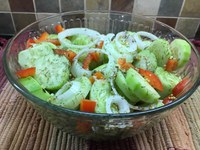Prairie Fare: In a Pickle Over a Side Dish?
(Click an image below to view a high-resolution image that can be downloaded)
By Julie Garden-Robinson, Food and Nutrition Specialist
NDSU Extension Service
“Please enjoy these fresh pickles. Your food will be out shortly,” the server said as she placed a plate of cucumber slices in front of us. They were sprinkled with dill weed and had a nice crunch.
I was in a restaurant in another state, and the somewhat sweet yet vinegary flavor and crisp texture made me nostalgic for home. The pickles were very tasty and soon the serving plate was empty.
When I was young, we used to have fresh-from-the-garden cucumber slices and onions marinated in a vinegar and sugar brine. I would place a couple of slices on my plate to appease my parents, who wanted me to enjoy different foods. I wasn’t always keen on trying “different” foods back then.
When guests came over, pickles or relishes of some sort always were served as a side item. I gradually grew to like the various renditions of pickled vegetables that were on our menus regularly.
However, despite their coaxing, pickled pigs feet did not make it on my plate. I had to put my own foot down on some things.
Our pantry was stocked with a wide variety of canned pickles and relishes, from beet pickles to watermelon pickles. Some pickles were sweet because the brine contained a lot of added sugar and other pickles were quite sour.
Cabbage was fermented to form sauerkraut in a crock with a heavy cover in a cool room in our basement.
Preserving food by fermentation predates all of us by thousands of years. Pickles can be made from almost any vegetable or many fruits, and their history dates back to 2000 B.C.
In the absence of refrigeration, early people figured out that salt helps prolong the shelf life of foods. Perhaps someone dropped vegetables in salty seawater and a couple of days later, they noticed some bubbling as the vegetables began to ferment. The salt prevented the dangerous bacteria from growing and allowed the beneficial bacteria an opportunity to grow.
We aren’t sure what happened next in history because no one had Facebook or Twitter to post photos.
Evidently, someone was brave enough to have a taste of the sour vegetables. Or perhaps they noticed that an animal ate the vegetables in the salty brine and survived.
These early food scientists set the stage for a wide range of foods that have become very popular throughout the world. Lactic acid bacteria on the vegetables convert natural sugars to acid, and salt helps the process. Acidic foods stay safe longer.
Fermented foods are a growing trend in our food supply, and different countries have introduced various fermented or pickled foods to world cuisine. Kimchi, which is a spicy fermented cabbage, originated in Korea. Pickled daikon radishes have long been popular in Japan, and pickled eggplant is one of the signature items from Italy.
Sauerkraut, by the way, originated in Europe. To make sauerkraut, you just need salt, chopped cabbage and a covered container. Then natural fermentation takes over. On the other hand, most “pickled” vegetable recipes contain vinegar, salt and spices.
Eating fermented foods may have some health benefits. You may have heard the term “probiotics,” which literally means that the food supports life because it contains some beneficial lactic acid bacteria. Probiotic-rich fermented foods may offer some health benefits to our immune system and digestive system. They may help restore levels of healthy bacteria in our gut.
The fermentation process also may enhance the ability of our bodies to use the nutrients in food. Besides fermented vegetables, foods with “live and active cultures,” such as some types of yogurt, sour cream and buttermilk, are sources of probiotics.
If you are inspired to try making sauerkraut or a wide range of pickled foods, visit https://www.ag.ndsu.edu/food and click on “Food Preservation,” then “Ferment” or “Pickle.”
As we complete our fall harvest of fresh local vegetables, here’s a tasty recipe for fresh pickles to try.
Quick Pickled Cucumbers, Peppers and Onions
1/2 c. vinegar
1/2 c. water
1 1/2 Tbsp. sugar
1 1/2 tsp. mustard seed
1 1/2 tsp. salt
1 tsp. minced garlic
1 1/2 tsp. dill weed (or 4 Tbsp. chopped fresh dill)
5 c. cucumber slices
1/2 small onion, sliced into rings
1/2 red bell pepper, sliced into 1-inch strips
Heat vinegar, water, sugar, mustard seed, salt and garlic until sugar dissolves. Rinse cucumbers, then peel and slice. Prepare onion and red bell pepper as described. Mix vegetables in bowl and add dill weed, stirring gently to coat. Pour vinegar mixture over vegetables. Refrigerate for at least two hours, stirring at least once to submerge vegetables in brine. Remove pickled vegetables with a slotted spoon to a serving dish and return the remaining vegetables to the refrigerator. (Note: This is not a tested recipe for canning. Enjoy them fresh.)
(Julie Garden-Robinson, Ph.D., R.D., L.R.D., is a North Dakota State University Extension Service food and nutrition specialist and professor in the Department of Health, Nutrition and Exercise Sciences. Follow her on Twitter @jgardenrobinson)
NDSU Agriculture Communication - Sept. 7, 2017
| Source: | Julie Garden-Robinson, 701-231-7187, julie.garden-robinson@ndsu.edu |
|---|---|
| Editor: | Ellen Crawford, 701-231-5391, ellen.crawford@ndsu.edu |



